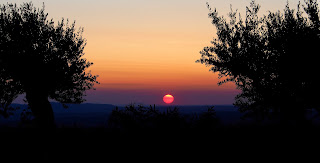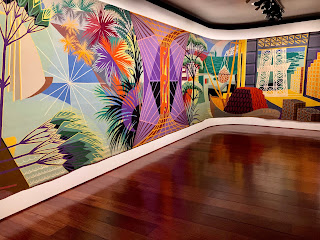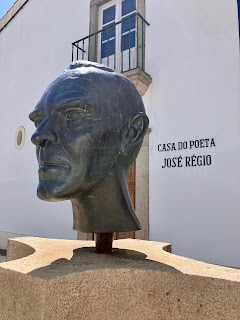We walk down early for our 8:05 bus (I had been up to the castle earlier for the sunrise ... it is only 200m or so from our casa).
On the way down through town to the bus station, a market is being set up in the Pedro V Square. We buy 2 bread rolls and a boleimas (a traditional pastry with apple and cinnamon) from a pastelaria. They really want small change for everyday purchases - even a 10€ note is too big.
On arrival in Portalegre, we walk a short distance to our hotel to leave our luggage. We plan on an easy day: no particular agenda.
Because of its proximity to the border with Spain, Portalegre was of strategic importance during the Middle Ages. The city prospered after the Renaissance period as evidenced by the many buildings (churches, palaces) in Baroque style in the historical centre.
Within the walls, there are plenty of decaying Baroque manors, a legacy of the silk manufacturing industry that flourished in the area. The whole industry sank in 1703 when the Methuen Treaty introduced English products into the market. However, nowadays, Portalegre is still loyal to its heritage of fine fabrics, even preserving the factory to produce exquisite tapestries by famous artists and there is an extraordinary museum of tapestries.
This is the Tapeçaria de Portalegre museum - oh my goodness: how gorgeous. Portalegre became the capital of the Portuguese mural tapestry in the middle of the 20th century. The manufacturer collaborates with the artist to produce an exact copy in tapestry form - using thread of over 7000 different colours. Mind-boggling!
There is ABC (another bloody castle) here but it is of lesser consequence than the Sé Catedral de Portalegre which really dominates the skyline in this city and was built in the 16th century; it is late Renaissance style and was later renovated in Baroque style (1737 to 1798).
The Museu Municipal nearby has an exhibition of photographs of the restoration: so much work, so much attention to detail. A guide came with the price of the entry and he was very passionate as he took us from floor to floor speaking to us about the religious exhibits some of which are from former convents that were converted to public buildings due to the prohibition of religious orders in 1834 and the industrial revolution. Antonio was very informative and interesting.
We set off after this to find a place for a ‘picnic’ lunch and aimed for the Plaça da Republica. Perfect! Chairs. Shade. And after we had added cheese to our fresh bread rolls (from the pastelaria this morning in Castelo de Vide), we went to one of the bars in the square and had a wine/beer (all local everywhere we go) in the sun under one of the large umbrellas. Added another bandaid to one of my feet … argh.
There is one more place we can visit with our museo 'combo' ticket: the Casa-Museu José Régio, the home of poet José Régio (1901-1969) while he was a teacher in Portalegre. It contains an extensive collection of religious and regional art collected throughout the course of the poet's life: shrines, oratorios, books, ceramics, etc. This probably was a bit of a stretch when it comes to sight-seeing. The guide tried her best with her just passable English, but it was clear MF couldn’t wait to get out of there.
There once was a cork factory here; we walked past it on our way back to our hotel: two enormous brick chimneys dominate the skyline. Founded in 1835 by Englishman Thomas Reynolds and later purchased by another Briton George Robinson, the factory was a major employer in Portalegre (with more than 2000 workers at its peak) coinciding with the decline of the woollen textile factories in the city. Production declined in the second half of the 20th century and the place closed for good in 2009. One could tour it once but sadly it has been abandoned.
We checked in and were very happy to put our feet up. We are in a hotel tonight; we’ve been loving our apartments but a hotel every now and then is fine - even if no kettle!!! It is quite hot by now, even in the late afternoon.
What had been intended to be an easy day, WAS! - sort of, but still involved lots of walking (7.45 kms)!
Soup (sopa) for dinner. Delicious - they make great soups here, especially the tomato soup.










No comments:
Post a Comment